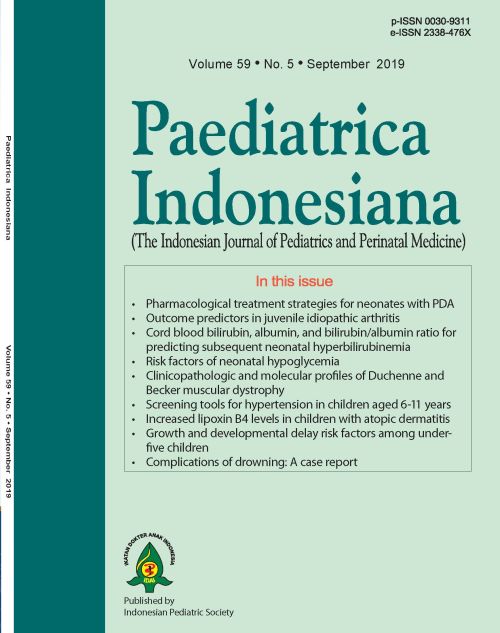Cord blood bilirubin, albumin, and bilirubin /albumin ratio for predicting subsequent neonatal hyperbilirubinemia
Cord blood bilirubin, albumin and bilirubin albumin ratio and subsequent Pathological jaundice
DOI:
https://doi.org/10.14238/pi59.5.2019.244-51Keywords:
cord blood bilirubin; cord blood albumin; cord blood bilirubin albumin ratio; significant hyperbilirubinemiaAbstract
Background Early discharge of healthy term newborns after delivery has become a common practice, because of medical and social reasons, as well as economic constraints. Thus, the recognition, follow-up, and early treatment of jaundice has become more difficult as a result of early discharge from the hospital. Since the dreaded complication of neonatal hyperbilirubinemia is kernicterus, an investigation which can predict the future onset of neonatal pathological jaundice is needed.
Objective To investigate the predictability of neonatal hyperbilirubinemia by using cord blood bilirubin, albumin and bilirubin/albumin ratio.
Methods This study was conducted on 300 healthy newborns. Umbilical cord blood was used to measure albumin and bilirubin. All infants were regularly followed up to 5th day of life. Neonates were divided into two groups: group A was consisted of neonates who developed jaundice which was in physiological range, while group B was consisted of neonates who developed neonatal hyperbilirubinemia (requiring phototherapy or other modality of treatment). Babies suspected to have bilirubin level which cross physiological limit on any day after birth were subjected to serum bilirubin measurement. Infants whose serum bilirubin level measurement revealed bilirubin levels crossing physiological values were sent to nursery for phototherapy.
Results The incidence of neonatal hyperbilirubinemia was 11%. Statistically significant correlations between cord blood bilirubin, albumin, and bilirubin/albumin ratio to the development of neonatal hyperbilirubinemia were observed. On ROC analysis, cut-off points to predict significant hyperbilirubinemia in newborn were cord blood bilirubin >3 mg/dL (sensitivity 60.61%, specificity 97.63%), albumin <2.4 mg/dL (sensitivity 78.79%, specificity 98.13%), cord blood bilirubin/albumin ratio >0.98 (sensitivity 78.79%, specificity 95.51%).
Conclusion Cord blood total bilirubin, albumin. and bilirubin/albumin ratio are excellent parameters to predict the occurrence of neonatal hyperbilirubinemia. However, cord blood albumin is better compared to cord blood bilirubin and bilirubin/albumin ratio.
References
2. Maisels MJ. Jaundice. In: MacDonald MG, Seshia MMK, Mullett MD, editors. Neonatology: Pathophysiology and Management of the Newborn. 6th ed. Philadelphia: Lippincott Williams & Wilkins; 2005. p. 768-846.
3. Cloherty JP, Eichenwald EC, Hansen AR, Martin CR, Stark AR. Cloherty and Stark’s Manual of newborn care: Neonatal hyperbilirubinemia. 7th ed. Philadelphia: Wolter Kluwer; 2008. p. 336?7.
4. Maisels MJ, Newman TB. Kernicterus in otherwise healthy, breast-fed term newborns. Pediatrics. 1995;96:730-3.
5. Norr KF, Nacion K. Outcomes of post partum early discharge, 1960-1986. A comparative review. Birth. 1987;14:135-41.
6. American Academy of Pediatrics, Provisional Committee for Quality Improvement and Subcommittee on Hyperbilirubinemia. Practice parameter: management of hyperbilirubinemia in the healthy term newborn. Pediatrics. 1994;94 :558-62.
7. Cherian AG, Soldin SJ, Hill JG. Automated Jendrassik-Grof Method for Measurement of Bilirubin in Serum with the Greiner Selective Analyzer (GSA II D), and Comparison with the Method Involving Diazotized 2,4-Dichioroaniline. Clin Chem. 1981;5:748-52.
8. Awasthi S, Rehman H. Early prediction of neonatal hyperbilirubinemia. Indian J Pediatr. 1998;65:131-9.
9. Randev S, Grover N. Predicting neonatal hyperbilirubinemia using first day serum bilirubin levels. Indian J Pediatr. 2010;77:147-50.
10. Dhanwadkar SS, Rasalam CS, Masood Z. Effectiveness of early clinical assessment and bilirubin estimation for prediction of neonatal hyperbilirubinemia. Int J Contemp Pediatr. 2016;3:477-84.
11. Alpay F, Sarici SU, Tosuncuk HD, Serdar MA, Inanc N, Gökcay E. The value of first-day bilirubin measurement in predicting the development of significant hyperbilirubinemia in healthy term newborns. Pediatrics. 2000;106:16-21.
12. Aiyappa GKC, Shriyan A, Bharath R. Cord blood albumin as a predictor of neonatal hyperbilirubinemia in healthy neonates. Int J Contemp Pediatr. 2017;4:503-6.
13. Pahuja M, Dhawan S, Chaudhary SR. Correlation of cord blood bilirubin and neonatal hyperbilirubinemia in healthy newborns. Int J Contemp Pediatr. 2016;3:926-30.
14. Thakur P, Mangashetty RB, Pawar SD. Cord blood albumin and cord blood bilirubin in early detection of neonatal hyperbilirubinemia. Int J Sci Res (IJSR). 2017;6:1327-9.
15. Alalfy M, el lithy A, EzzEldin ZM, Mansi YA, Hamed A, Mostafa MB, et al. Role of bilirubin and albumin in cord blood as predictors for neonatal hyperbilirubinemia. J Gynecol Res. 2018;4:1-14.
16. Bernaldo AJ, Segre CA. Bilirubin dosage in cord blood: could it predict neonatal hyperbilirubinaemia? Sao Paulo Medical J. 2004;122:99-103.
17. Taksande A, Vilhekar K, Jain M, Zade P, Atkari S, Verkey S. Prediction of development of neonatal hyperbilirubinemia by measuring umbilical cord bilirubin. Curr Pediatr Res. 2005;9:5-9.
18. Agarwal R, Deorari AK. Unconjugated hyperbilirubinemia in newborns: current perspective. Indian Pediatr. 2002;39:30-42.
19. Rostami N, Mehrabi Y. Identifying the newborns at risk for developing significant hyperbilirubinemia by measuring cord bilirubin levels. J Arab Neonatal Forum. 2005;2:81-5.
20. Venkatamurthy M, Murali SM, Mamatha S. A comparison study: cord serum albumin is compared with serum bilirubin as a risk indicator in predicting neonatal jaundice. J Evolution Med Dent Sci. 2014;3:4017-22.
21. Ramteke S, Shrivastav J, Agrawal A, Mishra NR, Saravanan AT, Tikkas R. Comparison of cord bilirubin and bilirubin albumin ratio to predict significant hyperbilirubinemia in healthy full-term neonates. Indian J Child Health. 2018;5:108-11.
Downloads
Published
How to Cite
Issue
Section
License
Authors who publish with this journal agree to the following terms:
Authors retain copyright and grant the journal right of first publication with the work simultaneously licensed under a Creative Commons Attribution License that allows others to share the work with an acknowledgement of the work's authorship and initial publication in this journal.
Authors are able to enter into separate, additional contractual arrangements for the non-exclusive distribution of the journal's published version of the work (e.g., post it to an institutional repository or publish it in a book), with an acknowledgement of its initial publication in this journal.
Accepted 2019-06-24
Published 2019-06-24


















